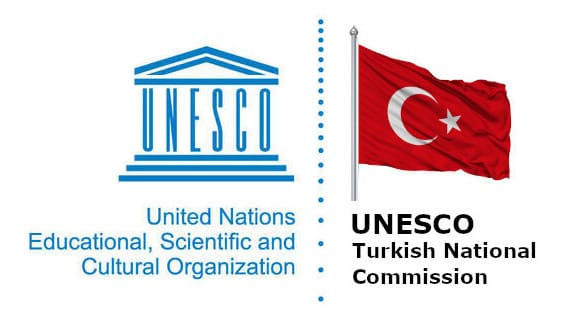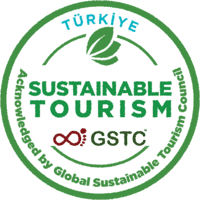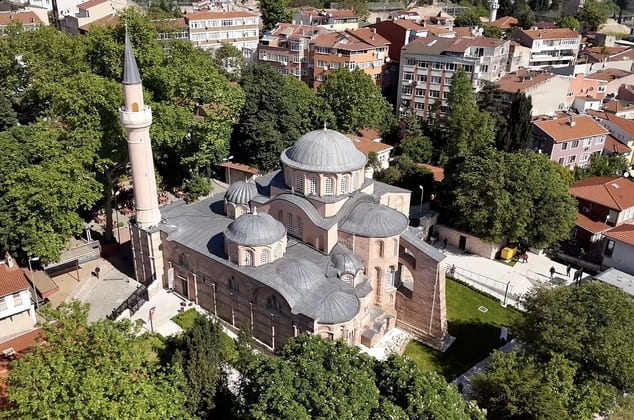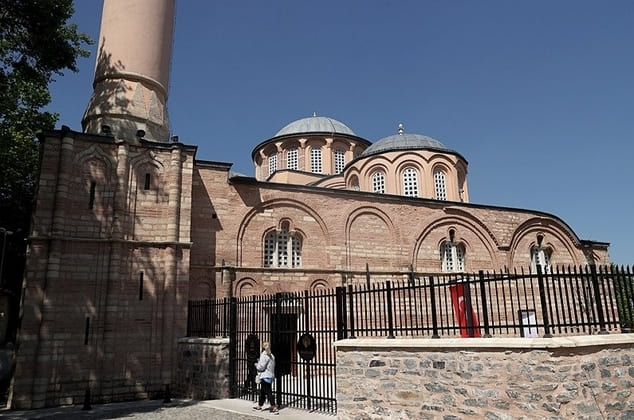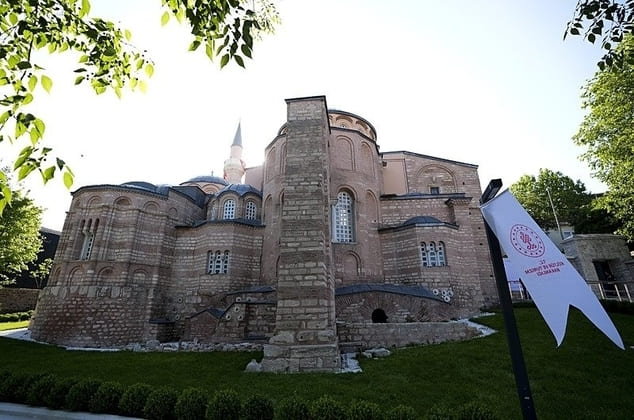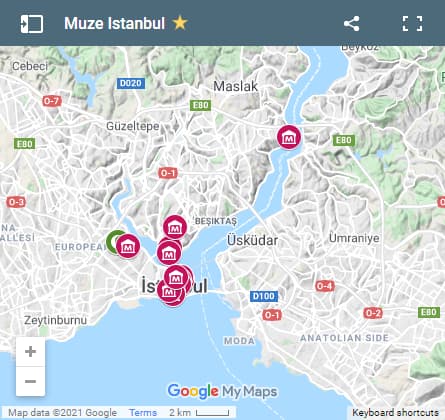KARİYE MOSQUE, INDISPENSABLE TO THE WORLD OF PAINTING
Formerly Church of St. Saviour in Chora is renowned worldwide for its well-preserved mosaics and frescoes. It presents important and beautiful examples of East Roman painting in its last period. The idea of depth in mosaics and the moving style in figures are of outstanding artistic significance in the Middle Ages, foretelling the Renaissance period.
The name “Kariye” (Turkish means: village) originated from an ancient Greek word "Khora" (χώρα) means literally "in the fields" or "in the countryside" and changed into a Turkish word because the old church and monastery remained outside the walls of Constantinople Theodosian walls which built in 408-450. However, the fact that the word Khora is written along with the names of both of them on the mosaics depicting Jesus and Mary inside the church shows that it has a mystical meaning too. Chora Church was originally built in the early 4th century as part of a monastery complex outside the city walls and then during the reign of Emperor Iustinianos in the 5th century. Repairs and additions have changed the original plan considerably. Today's building has a ciborium architecture plan from the 14th century.
HISTORY
A CANVAS OF FAITH: DAZZLING MOSAICS AND FRESCOES
Centuries later, in the 11th century, the church underwent a grand transformation, emerging as a majestic structure built in the quincunx (inscribed cross) style. However, its true artistic zenith arrived in the 14th century under the patronage of Theodore Metochites, a scholar and statesman. Metochites' vision adorned Chora with a stunning array of mosaics and frescoes. These intricate artworks, covering nearly every inch of the interior, narrate stories from the Bible and the life of Christ. Renowned for their vibrant colors, expressive figures, and masterful technique, these masterpieces represent a pinnacle of Late Byzantine art. They stand as testaments to the theological debates and artistic innovations of the era, offering visitors a unique glimpse into the Byzantine world.
GLORIOUS OTTOMAN EMPIRE RULING PERIOD (1299-1922)

Chora Church which was used as a palace church and a chapel in important religious ceremonies, continued to function as a church for a while. In 1511, it was converted into a Mosque by Atik Ali Pasha, the grand vizier of Bayezid II. Details of that period consist of the minaret in the southwest corner and the niche to the east of the main room. It was converted into a museum in 1945.
In 1948, Thomas Whittemore and Paul A. Underwood from the Byzantine Institute of America and the Dumbarton Oaks Center for Byzantine Studies, sponsored a restoration program. From that time on, the building ceased to be a functioning mosque. In 1958, it was opened to the public as a museum.
Turkish Council of State, which is Türkiye's highest administrative court, ordered in 11/11/2019 that it was to be reconverted to a Mosque. its status changed to a Mosque by a presidential decree and promulgated on the Official Gazette in 21/08/2020.
After a four year-long extensive restoration effort, Chora Mosque reopened its doors for worship and visitors on May 6, 2024 by the Directorate General Of Foundations Under The Ministry Of Culture And Tourism. The central chamber, referred to as the ‘Naos’, has been embellished with carpets and furnished with a pulpit, while the marble mihrab still stands from its previous use as a mosque.
The Chora owes its admirable 14th century-made frescoes and mosaics to Theodoros Metokhites who was in charge of treasury. In the outer narthex (generally western entrance section in eastern Roman basilica and churches), there are mosaics about the life of Jesus Christ and in the inner narthex about the life of Virgin Mary's.
Frescos with a vivid narrative depict important scenes from the Christian theology. The colorful and high-quality marble decorations on the floor and wall surfaces of the Chora deserve attention.
FOREIGN TOURIST VISITING INFORMATION
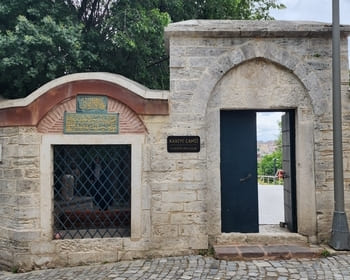
Kariye Mosque's opening hours are daily from 09:00 a.m. to 6:00 p.m. for tourists. As of August 19, 2024, a visitor management plan has been put in place for conservation purposes, requiring a 20€ (Euro) entrance fee for foreign visitors. Museum Passes are not accepted for entry to the Chora Mosque. Turkish citizens and Muslim foreigners visiting for worship can enter the mosque free of charge. Kariye Mosque is closed for visits on Fridays as it is used for religious services. To ensure a peaceful atmosphere for worshippers, the Kariye Mosque will stop admitting tourists 15 minutes before each prayer time. During the prayer hours/periods, visitors are not allowed to be inside the mosque. Standard mosque visiting etiquette required in central area departments (image above: ‘Naos’, ‘Inner Narthex’, ‘Annex’). Shorts are not permitted for either men or women. Women are also required to cover their heads with a scarf. Head and body coverings are available at the entrance ticket booth with various prices. Headphones are also available for purchase at the entrance ticket booth, allowing you to listen to audio commentary about the history of Chora Mosque.
To access the Chora Mosque's visiting area, visitors must now enter the grounds from Kariye Türbesi Sk. (Street) on the north side and proceed to the entrance on the south side of the building. All visitors must undergo security checks at the garden security cabin. The use of flash photography, supplemental lighting, or similar equipment is not permitted since artworks sensitive to light and other people in the mosque find it annoying.
Please note that the mosaics in the building's prayer section (image above: ‘Naos’) covered with curtains in accordance with Muslim traditions. Three mosaics, depicting Jesus and Mary, are discreetly concealed above the entrance door of Naos (aka, ‘Nave’) and on either side of the pulpit using special techniques. Restoration team from the Culture and Tourism Ministry meticulously cleaned and restored the exterior mosaics using specialized methods.
Prohibited items
- Weapons of any kind
- Marking materials, such as spray paints, inks, adhesives etc.
- Outside food or drinks (unless for medical purposes)
- Luggage of any size or type
- Umbrellas
- Pets. Guide dogs and service dogs are the only pets allowed.
- Banners and signs
- Strollers
Information about the history of Kariye Mosque is available in 9 different languages. Please scan the QR on the information boards.
How to get Kariye (Chora) Mosque
Although it is a little bit off the beaten track and situated near the ancient city walls, the most convenient way to get to Kariye Mosque is a taxi ride, Preferably ordered by concierge service of your accommodation or getting one from a nearby taxi station. Another popular transportation method to reach the Mosque is by taking buses from the city’s main centers, such as Taksim, Eminönü, or Mecidiyeköy, to the Edirnekapı neighborhood where the Chora Mosque is located.
İstanbul’s rail system boasts a large railroad network, connecting numerous locations across both the European and Asian sides of the city. The T4 - Tram 4 line has the nearest station by the mosque (Edirnekapı station). T4 integrates seamlessly with other transportation lines at 4 stations;
- T1 - Tram 1 line which runs through İsatnbul's historical peninsula (integrated at Topkapı Station)
- M1A, M1B - Metro lines (integrated at Vatan Station)
- M7 - Metro 7 line (integrated at Kiptaş-Venezia Station)
- Metrobus (BRT) line (integrated at Şehitlik Station)
The Edirnekapı station for the T4 Tram is located outside the city walls. After exiting the underground tram platform, head toward the entrance road to Edirnekapı walls.
Admission tickets, E-tickets
Admission tickets can be purchased from the ticket booth and online (Skip-the-Line) through official seller DEM MUSEUMS with below link. Children aged 8 and younger enter for free. There are no Museum Passes available for visiting the Kariye Mosque.
WHILE YOU ARE HERE
After soaking in the historical and artistic grandeur of Kariye, visitors can enjoy a stroll through the charming streets and nearby Tekfur Palace Museum which is thought to be a part of the Blachernae Palace complex and have been used as the official residence of Byzantine emperors since the 13th century. One of İstanbul's prominent landmarks 16th-century the Mihrimah Sultan Mosque, which was commissioned by Mihrimah Sultan, Suleiman the Magnificent’s daughter, and it was skillfully designed by the chief imperial architect, Mimar Sinan, just a short walk away. There are also plenty of wooden houses great to be photographed and neighborhood cafes to have a rest when you are tired.
See Also
- http://en.istanbul.gov.tr/ | World Famous Frescoes
- https://islamansiklopedisi.org.tr/ | Kariye Camii
- https://en.kariyecamii.com/ | Kariye Mosque
- https://smarthistory.org/ | Chora’s brilliant Byzantine mosaics and frescoes

